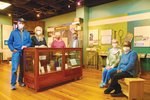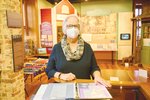




PITTSBORO — A new temporary exhibit at Chatham’s Historical Museum showcases the county’s Black history — from the triumphs to the tragedies — during Black History Month.
The display at the museum — located in the county’s historic courthouse in downtown Pittsboro — features three main components: a timeline of events in Chatham County from the start of the Civil War until present day, a bulletin board and binder filled with information about notable Black Chatham residents, and a display case with information regarding the six documented lynchings that occurred in the county.
“The idea was to have something about Black history in Chatham County, and Mary Nettles had the idea to do something about Black history out of this collaborative environment,” Museum Coordinator Cindy Schmidt said.
Nettles serves as the president of the Community Remembrance Coalition-Chatham (CRC-C) and Chatham Community branch of the NAACP. She said her vision for the display came from wanting to show Chatham’s history through a perspective that’s been historically repressed.
“Black history in Chatham is an essential part of the story of the county,” Nettles said. “The history needs to be told, the good and the bad.”
NAACP and CRC-C member Adele Kelly was also involved in the development of the display. She said one of the exhibit’s intentions is to address some of the county’s harsher history, including Jim Crow laws and violence toward people of color.
“Although no one alive today participated in this violence, its shadow is still with us,” Kelly said. “The exhibit tells the hard history of the Jim Crow white supremacy system that deprived our Black neighbors of their rights and enforced that system with vigilante mob violence.”
This “vigilante mob violence” included Chatham’s six documented lynchings. One of the victims — Eugene Daniel — was just 16 years old when he was murdered by an angry mob in Pittsboro after being accused of attempted rape in 1921.
The museum’s display case features Daniel’s death certificate, along with soil from the site of his murder; Daniel was memorialized in a day-long series of events on the 100th anniversary of his lynching last September. The other lynchings involved married couple Harriet and Jerry Finch, as well as three men named Lee Tyson, John Pattishall and Henry Jones.
“It is true history that has been hidden and never told — we need to remember what our country has forgotten,” Nettles said. “Everyone must tell the whole truth and accept the hard history.”
The timeline created by museum staff features some of that “hard history” — such as the Civil War, the start of Jim Crow laws and the Civil Rights Movement — and shows what was happening around the county during that same time, including those lynchings.
“Putting those (the lynchings) in context with other events in Chatham County is what we were trying to do,” Schmidt said. “We have to recognize what was going on in the national and state environment in order to put the Chatham events in context.”
The timeline wall also asks visitors two questions, according to Schmidt — what was happening when you were born, and what surprised museum-goers about the sequence of events highlighted on the board?
Why those questions? Schmidt said she wanted visitors to see how quickly change can come and how drastic it can be.
“We’re hoping people will take a look at the sequence of events and notice that the last lynching in Chatham County was in 1921, and there was a Black principal at Horton High starting in 1948,” Schmidt said. “The placement of the dates should help people understand what was going on in the county.”
Museum volunteer and exhibit coordinator Wanda Pender helped arrange the Black history exhibit and display using information provided by Nettles, Kelly and her own research.
The third part of the exhibit — a visual dedicated to the lives of notable Black Chatham residents — features the biographies of various citizens from the museum’s website.
“This took a lot of research and thinking to try to find what you need for the museum,” Pender said. “It’s a lot of research and communication to try and figure out what you are trying to do.”
Those featured on the bulletin board include some of Nettles’ personal role models from Chatham’s history.
“I stand on the shoulders of several Black and white citizens in Chatham County, including the 18 individuals on the board,” Nettles said.
The significance of the Black history display is different for each museum volunteer and others involved in arranging the exhibit. For Schmidt, she sees it as an example of change, as well as the emergence of Black leadership in Chatham County.
“You can take a look from 1964 or so on through today and see how many people in Chatham County leadership have been people of color,” Schmidt said. “I think it is a marvelous way to showcase all of these folks that since 1964 have been out there and putting themselves into leadership positions.”
For Pender, she was able to learn about the Chatham of the past and compare it to the Chatham County of today. She said she hoped other lifelong residents like herself can learn from the harsher aspects of Chatham’s past.
“The lynchings should be considered a part of that history, but look where we are today,” Pender said. “The museum as a whole will give you an idea of what Chatham County used to be, and then you can compare it to where we are now.”
For Nettles and Kelly, the exhibit also serves as a way to help start those hard conversations about the history of racism.
“The exhibit’s intent is to encourage Chathamites to visit the museum and start conversations which help with the understanding of our past,” Kelly said. “This broadened knowledge will help us grow, foster better race relations and allow our county to move forward together. We hope to encourage communication and help the community heal.”
By acknowledging the tragic parts of Chatham’s history, Nettles said the community can work more toward finding equality for all residents.
“It is important for more Chatham County residents to be aware of and accept the true history of the county,” she said. “Racism affects everyone, not just the Black and Brown population. We must be willing to acknowledge the issues that divide us and move forward. What’s done is done, but now, everyone has the opportunity to do better and contribute to a future favoring equality and justice for all.”
Reporter Taylor Heeden can be reached at theeden@chathamnr.com.